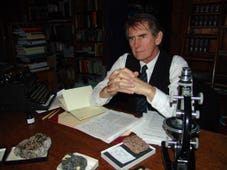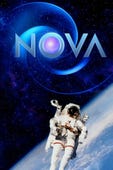Join or Sign In
Sign in to customize your TV listings
By joining TV Guide, you agree to our Terms of Use and acknowledge the data practices in our Privacy Policy.
NOVA Season 32 Episodes
Season 32 Episode Guide
18 Episodes 2005 - 2005
Episode 1
Welcome to Mars
Tue, Jan 4, 2005 60 mins
"Welcome to Mars" follows scientists and engineers at NASA's Jet Propulsion Laboratory as they analyze data and photos sent back from the rovers Spirit and Opportunity. "We're in Mars Geology 101 here," says one scientist. The long work days (and nights) are annoyingly staggered by a 40-minute difference between the Earth and Mars day, leading to "Martian jet lag." But the team does find conclusive evidence of water, which could be momentous. As the narrator puts it: "Life had a chance."
Episode 2
The Boldest Hoax
Tue, Jan 11, 2005 60 mins
"The Boldest Hoax" chronicles English fossil hunter Charles Dawson's 1912 discovery of the "missing link" between apes and humans---and the discovery that this "Piltdown Man" was a fraud some 40 years later. "Were monkeys being made of the scientists?" wonders Richard Millner of the American Museum of Natural History. Certainly. But who might have done it, and why? Sherlock Holmes creator Arthur Conan Doyle had both motive and opportunity, but suspicion falls most heavily on Dawson himself.
Episode 3
Supersonic Dream
Tue, Jan 18, 2005 60 mins
"Supersonic Dream" chronicles the short history of the Concorde, from the drawing board in the 1950s to its final flight in 2003. Literally faster than a speeding bullet, the elegant SST was popular among jet-setters who could afford its high fares. But cost---and the sonic boom it created---meant that the French-British consortium that built it could sell it only to Air France and British Air. Still, it was, as jet-setter David Frost puts it, "the only way to be in two places at once."
Episode 4
The Viking Deception
Tue, Jan 25, 2005 60 mins
"Science Now," an occasionally airing "Nova"-offshoot science magazine hosted by Robert Krulwich, begins with reports on hurricanes, the science behind empathy and why sand dunes can "sing." Also: a profile of young engineer James McLurkin, who has, Krulwich says, "analyzed and planned every minute of his life," from tying his shoes to romance. Regarding empathy, the brain "mirrors movement it sees," says Krulwich. And a "CAT scan for hurricanes" could help New Orleans escape devastation.
Episode 5
The Viking Deception
Tue, Feb 8, 2005 60 mins
They probably did discover America, but, according to "The Viking Deception," their road map is a fake: The Vinland Map dates from the 1950s, not the 1440s. The hour traces it back to 1957, when it was first taken to the British Museum for authentification. The trail then leads to a shady fascist, Mellons and Gettys, Yale, an Austrian Jesuit and a number of laboratories. But some challenges have nothing to do with technology. For instance, one critic noted that the Vikings didn't use maps.
Episode 6
Saving the National Treasures
Tue, Feb 15, 2005 60 mins
"Saving the National Treasures" follows the restoration and reencasement of the Declaration of Independence, the Constitution and the Bill of Rights between 2001 and 2003. The hour also traces the history of these "birth certificates of the nation," as narrator Liev Schreiber calls them, particularly the Declaration---the only one of the three to stress the ideal of equality. This, says civil-rights veteran Julian Bond, is "the centerpiece of our understanding of who we are as a people."
Episode 7
A Daring Flight
Tue, Feb 22, 2005 60 mins
"A Daring Flight" chronicles Frenchman Louis Bleriot's English Channel crossing in 1909, the first ever, and charts his grandson's attempt to re-create it in one of Bleriot's original planes. The Bleriot 11was "the Model T of the aviation industry," says narrator David Ogden Stiers, and its design took years. The hour also recalls the race among France's "militant aviators" to get their planes aloft. Bleriot won because he borrowed from the Wright brothers.
Episode 8
The Wave That Shook the World
Tue, Mar 29, 2005 60 mins
"The Wave That Shook the World" (on Dec. 26, 2004) offers an hour-by-hour timeline of the tsunami that killed 220,000 people and the earthquake (the fifth strongest in recorded history) that triggered it. The hour includes comments by scientists that are equal parts scientific dispassion and human emotion. But there's nothing dispassionate about the eyewitness accounts from Indonesia, Thailand and Sri Lanka. "It was like the aftermath of an atomic bomb," says photojournalist Geoff Mackley.
Episode 9
Sinking The Supership
Tue, Apr 19, 2005 60 mins
A primer on stem-cell research; and a profile of nanotechnologist Naomi Halas, who describes the potential of her work in treating tumors. (She also talks about how she navigates her male-dominated field.) Also: a homo sapiens predecessor that shared an Indonesian island with modern humans just 13,000 years ago; frogs that freeze themselves in winter and thaw in spring; the T. Rex lifespan and growth rate.
Episode 10
Einstein's Big Idea
Tue, Jul 26, 2005 60 mins
Tom and Ray Magliozzi, the hosts of NPR's "Car Talk," help Robert Krulwich explore the pros and cons of hydrogen as an automotive fuel in the third edition of the "Nova" newsmagazine offshoot "scienceNow." Also: melting glaciers in Greenland (there's 60 percent more melting now than a decade ago, according to reporter Peter Standring); the potential of RNA to "turn off" diseases; a profile of mathematicians Gregory and David Chudnovsky.
Episode 11
Mystery of the Megaflood
Tue, Sep 20, 2005 60 mins
"Mystery of the Megaflood" examines how a bizarre landscape in eastern Washington state known as the Scablands might have been formed. The consensus of opinion: "one of the biggest geological catastrophes ever," says the narrator . Scientists now think that the Scablands' gorges, dry waterfall beds, scattered boulders and "potholes" were formed some 15,000 years ago when a natural ice dam holding an ancient lake burst. But, as is followed here, that theory took some 80 years to develop.

Episode 12
Sinking the Supership
Tue, Oct 4, 2005 60 mins
"Sinking the Supership" charts the short life of Japan's Yamato, the largest battleship ever built. It was sunk in April 1945 while defending Okinawa. The hour, which features comments from several of its 260 survivors (more than 3000 died) and follows submersibles as they view its wreckage, explores reasons why battleships became vulnerable in the years following WWI. The chief one: air power. The Yamato, says one of the 400 U.S. pilots who attacked it, "was a perfect target."
Episode 13
Einstein's Big Idea
Tue, Oct 11, 2005 120 mins
"Einstein's Big Idea" weaves docudrama vignettes and expert commentary to chronicle advances in scientific knowledge that led to his relativity theory---"the fantastic connection between energy, matter and light," says narrator John Lithgow. The dramatizations hopscotch from 18th-century France and 19th-century Britain to the splitting of the atom before WWII. But the main focus is on Einstein (played by Aidan McArdle). "With light," says Lithgow, "he would reinvent the universe."
Episode 14
Storm That Drowned A City
Tue, Oct 18, 2005 60 mins
An update on a January 2005 report on hurricanes that assesses damage caused by Hurricane Katrina highlights this edition of "scienceNow." Also: attempts to create artificial life in laboratories by mimicking the origins of life 3.5 billion years ago and by "designing" genes; scientists in Florida searching for the cause of lightning; a North Carolina veterinarian who performs cancer surgery on goldfish; and a profile of neuroscientist Erich Jarvis, an expert on birds' brains.
Episode 15
Volcano Under the City
Tue, Nov 1, 2005 60 mins
"Volcano Under the City" follows scientists as they seek "the holy grail of vulcanology": lava samples from the pit of Congo's very active Mount Nyiragongo, which endangers some two million people living in its shadow. Indeed, the volcano's fissures extend under the neaby city of Goma. The mission (undertaken by French and Italian scientists) proves to be dangerous, but the samples could help in predicting an eruption far greater than one in 2002, which killed 100 and left 120,000 homeless.
Episode 16
Hitler's Sunken Secret
Tue, Nov 8, 2005 60 mins
"Hitler's Sunken Secret" explores the Nazi quest for atomic weapons as it follows a mission to recover barrels of heavy water bound for Berlin from a Norwegian hydroelectric plant. The heavy water was being transported by ferry across Norway's Lake Tinnsjo in February 1944 when the ferry was sunk by the Norwegian resistance. Scientists and historians want to know if the water could have been used in the bomb-making process, and how far along that process was.
Episode 17
Newton's Dark Secrets
Tue, Nov 15, 2005 60 mins
Isaac Newton (1642-1727), whose laws of motion remain a constant in the understanding of the world, is recalled in reenactments in this look back at his life and times. Included: his exploration of alchemy and religion.
Episode 18
Storm That Drowned a City
Tue, Nov 22, 2005 60 mins
An exploration of the devastation wrought on New Orleans by Hurricane Katrina details failures of levees and disaster-relief planning; why the city was unprepared; and what made Katrina so powerful. Also examined are the challenges involved in rebuilding the city.
